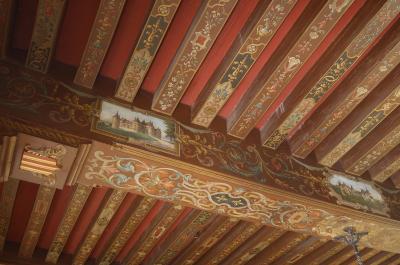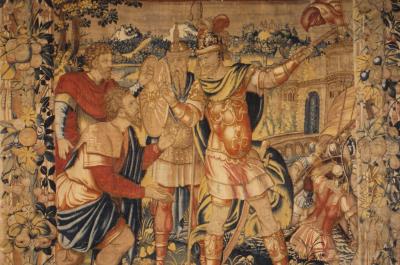The Billiards room

The billiard room was obviously where the game was played, but it was also the meeting-place of men, who came to smoke cigars after copious meals and to talk politics. It's one of the few rooms in the Château to have kept its 19th century polychrome ceiling with a decoration liberally inspired by the Renaissance. The cartouches and two interlaced “C's” refer to Charles the Second de Chaumont-Amboise.
The main beam features three views of the Château as it was at the time of the de Broglie family and at each end of the corbels, the Chaumont-Amboise family coat of arms and of the de Broglie family.
Two tapestries, woven in the 16th century in Brussels, depict episodes from the life of Hannibal: The Siege of Saguntum and Hannibal showing his lieutenants the Po Valley.
Tapestry depicting The Siege of Saguntum
After losing the First Punic War against Rome in the 3rd century BC, the city of Carthage looked for another way to reach Italy by land. The conquest of Spain would make it possible to keep a permanent army there, near Italy. The Carthaginian Senate tasked Hamilcar Barca with conquering the Iberian Peninsula, which he pulled off with success; his son-in-law Hasdrubal continued his exploits and appointed as First Lieutenant a certain Hannibal, Hamilcar Barca’s son. Hannibal quickly became the sole commander of the Carthaginian army. In 219 BC, he seized the initiative by opening hostilities against Rome and laid siege to Saguntum, a city allied with Rome. This is the scene that the tapestry depicts, where Hannibal is showing the city under siege to two emissaries who have come to make peace. The Siege of Saguntum was a provocation for the Eternal City; when the Carthaginian Senate refused to disavow its General-in-Chief, Hannibal, Rome declared war on the Carthaginians and so began the Second Punic War.
In the de Broglie family’s days, this tapestry was on display in the Guard Room. It was classified as a Historical Monument in 1954.
Billiards
The English word "billiards" is derived from the French "billard". This word is found in the 13th century poetic work, Le Roman de la Rose, designating a wooden stick with a bent head: a blueprint for the first billiard cues perhaps! As for the game itself, it evolved from an outdoor game played on lawns, rather like croquet, when the gentry took it indoors and reinvented it as a game to be played on a table in a special room. It's said that King Louis the Ninth ordered the first billiard table to be made. One also features in the 1514 inventory of Charlotte d’Albret, Duchesse de Valentinois. But it was during the reign of Louis the Fifteenth that the game became widely popular. The wooden table top was replaced first by marble, then by slate, which ensured stability and a perfect horizontality.


